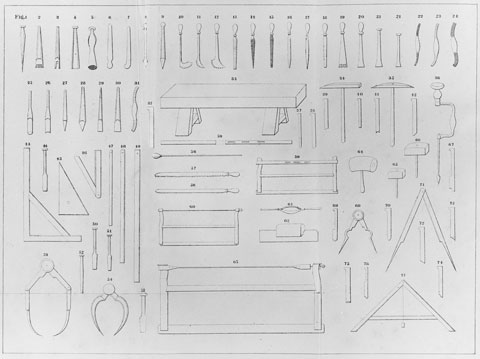
 |
| Figure 23 Illustration showing stone cutters’ tools illustrated in The Marble Worker’s Manual. No. 1 — square etching needle; nos. 2, 4, 19, 20, 64 — marteline chisels used for etching and with a mallet or sledge hammer, no. 5 — puncheons; nos. 8, 9, 27, 28 — partly flattened, very sharp etching needles called houguettes; no. 10 — hooks for sinking and leveling cavities; no. 11— round-nosed chisels for sinking and leveling cavities; no. 12 — sharp edged and notched scrapers for fluting; no. 19 — scrapers for fluting; no. 31 — parting tools bent round and steeled at each end to smooth areas difficult to reach; no. 34 — martelines (iron mallets pointed at one end, and diamond shaped at the other) used to pierce and shell of the marble without splintering; no. 61 — sebillas, or wooden bowls for holding the sand and water that would be thrown under the saw; no. 56 — wooden or metal ladles used with the sebillas; no. 62 — handsaws without teeth, used to cut stone or marble with the aid of sand or water. “A skillful workman often confines himself to making a deep groove in the Marble or stone, and then by a quick blow, separates the two pieces.” (Courtesy, Winterthur Museum Library: Printed Book and Periodical Collection.) |
|
|